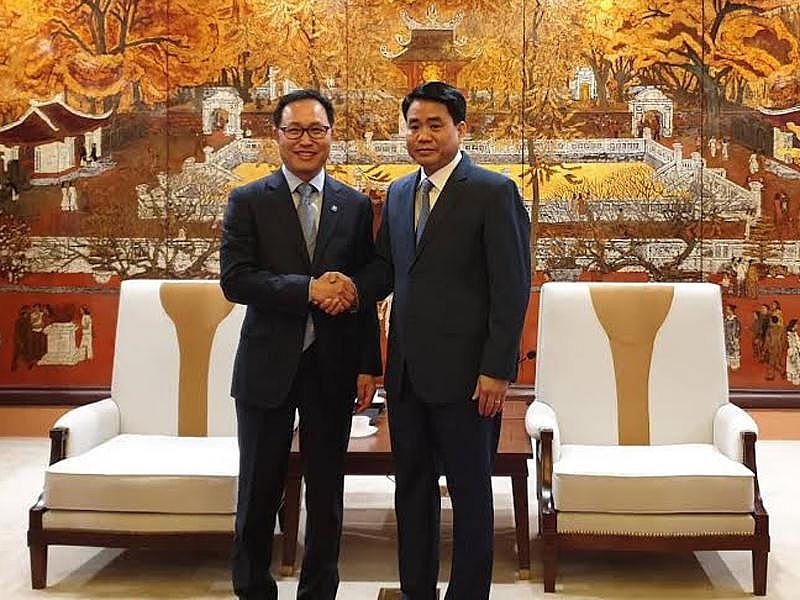Samsung eager to develop R&D centre in Hanoi
 |
| Samsung held a working session with the Hanoi People's Committee to discuss its plans in Vietnam |
In a working session with the leaders of the Hanoi People’s Committee, Choi Joo Ho, general director of Samsung Vietnam, expressed interest in developing the 18-storey project on an 116,000 square metre land plot to the west from West Lakeand hoped to receive support from Hanoi. The construction is expected to start in 2020 and be finished in 2022.
Choi said it will specialise in mobile phones and network devices, and is expected to take the lead in Samsung’s 5G technology development, contributing to the building of smart factories in Vietnam.
The centre will also strengthen the position of Vietnam as Samsung’s strategic hub in the region, and serve as the headquarters of Samsung in Vietnam.
Previously in March 2016, Hanoi granted the investment registration certificate to Samsung Vietnam for the $300 million R&D facility. According to the initial plan, SEV would build a 21-storey (which has been revised to 18 storeys) building on a three-hectare land plot in Hoang Mai district and employ 2,000 labourers in 2016 and eventually 4,000 in the upcoming years.
| The centre will also strengthen the position of Vietnam as Samsung’s strategic hub in the region, and serve as its headquarters in Vietnam. |
At the time, Samsung asked a wide range of preferential privileges for its R&D centre. Accordingly, SEV asked for a 50-year exemption from land lease fees, site clearance costs, and import tariffs on the R&D centre’s equipment and devices, and customs procedures to transfer goods between SEV and the R&D centre in Hanoi. Besides, SEV requested that the annual personal income tax of its employees in the centre be cut by half.
As a result, the Ministry of Planning and Investment and other relevant ministries, as well as the authorities of Hanoi have basically agreed to Samsung Electronics Vietnam’s (SEV) request for incentives.
Samsung has hired eight storeys of PVI Tower in Hanoi since 2012 for the Samsung Vietnam Mobile Research and Development Centre (SVMC), which has contributed around 10 per cent of the software market share of Samsung's smart phones and tablets globally.
Along with this centre, Samsung has an R&D centre in Ho Chi Minh City, which specialises in studying electronic household products instead of mobile phone as Hanoi.
Debuting in Vietnam in 1996, the Korean giant currently has three major manufacturing complexes in the country, including Samsung Vina Electronics in Ho Chi Minh City and the $2.5 billion Samsung Vietnam Electronics project in the northern province of Bac Ninh, which became operational in 2009. The remaining one is the $5 billion Samsung Vietnam Electronics Thai Nguyen complex, which went on stream in March 2014.
What the stars mean:
★ Poor ★ ★ Promising ★★★ Good ★★★★ Very good ★★★★★ Exceptional
Related Contents
Latest News
More News
- PM orders investment model for North–South high-speed rail (December 22, 2025 | 17:43)
- First members of Danang International Finance Centre revealed (December 22, 2025 | 17:39)
- Securing capital and efficiency for Vietnam’s 2026-2030 growth ambitions (December 17, 2025 | 10:00)
- Driving double-digit growth through green and circular transformation in Vietnam (December 17, 2025 | 09:00)
- Vietnam bucking trend in the global M&A landscape (December 16, 2025 | 14:20)
- Vietnam’s green transition demands collective financial action (December 15, 2025 | 12:00)
- VIR workshop highlights capital and policy for sustainable development (December 15, 2025 | 11:00)
- National Assembly approves pilot mechanisms to accelerate major projects in Hanoi (December 12, 2025 | 11:29)
- Vietnam eases policy approval requirements, simplifies foreign and outbound investments (December 11, 2025 | 17:53)
- Unpacking new momentum in Vietnam’s M&A market (December 10, 2025 | 09:59)

 Tag:
Tag:



























 Mobile Version
Mobile Version